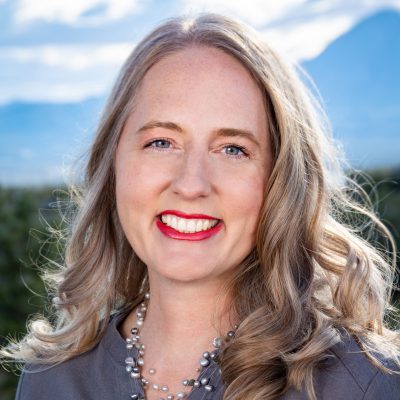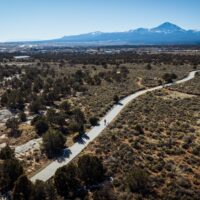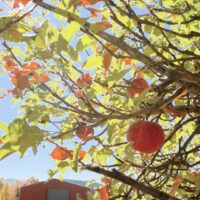The Four Corners region is home to many talented writers. A new book and nonprofit are giving them a platform. Read more

Cows graze under solar panels. Grazing cattle is one of many potential dual land use options involved in agrovoltaic projects. (Photo courtesy of Jack’s Solar Garden/Agrovoltaic Learning Center)
This story was produced through the Daily Yonder Rural Reporting Fellowship, with support from the LOR Foundation.
Rural communities are a necessary element of renewable energy development, but across the United States denizens of small communities protest solar farms cropping up across large swaths of land. Developing agrivoltaics, technologies combining solar and agriculture, could help reduce community pushback against solar development.
Solar and wind farms need space, infrastructure such as convenient transmission lines, and plenty of sun/wind to create power, but many rural areas are not prepared for the industrial development that large-scale renewable energy brings to their often previously quiet communities.
Agrovoltaics or dual-use solar can look like many different things, but at its core it is a solar array combined with some form of agriculture. Ways to implement agrovoltaics are to plant crops under solar panels or to graze sheep, cattle, or other animals around the panels. But depending on the type of agriculture, the panels may need to be raised to make room for the animals or crops, which can add additional costs to development. It can also refer to planting pollinator flowers under solar panels, which is not considered agricultural but is a common way to make a solar development dual use without increasing costs dramatically.
In the agricultural community of Dove Creek, Colorado, Colten Schlegel is hoping to start an agrovoltaics vineyard that will pave the way for similar development in the currently solar-averse communities of rural Southwest Colorado. Schlegel, who grew up in Dove Creek, knows the area well. He hopes his familiarity with the people, environment, and economy of the area will help him establish trustworthiness in the community, especially compared to developers coming from other areas.
Most solar arrays are initiated by development companies that have the upfront capital to build large-scale projects. These developers find land by leasing directly from landowners or public land offices. But landowners with solar leases generally only make money from the lease agreements and rarely get profits from the energy production itself.
“The biggest concern that I think most rural people have when it comes to anything around large corporations or heavy government oversight … is that that money isn’t going into the local economy,” said Schlegel.
He envisions a coalition of local farmers collaborating on an agrovoltaic or solar farm with the participants receiving direct compensation for the power, instead of only leasing land to developers. He also wants to provide resources to farmers who want to supplement income from agriculture with solar energy production income.
“If that money is going to the farmers, it’s going into the local economy… and it’s gonna strengthen the local power grid as well,” he said.
Hard Costs…
But there are challenges involved with agrovoltaics projects and one of the biggest ones is cost. Without policy to drive investment into agrovoltaics or dual-use development, there is no incentive for developers or utilities to spend more while developing solar.
Jack’s Solar Garden, in Longmont, Colorado, is the largest commercially active research site for agrovoltaics in the United States. Through partnerships with the University of Arizona, Colorado State University, the National Renewable Energy Laboratory, and Sprout City Farms, Jack’s Solar Garden aims to make agrovoltaics more accessible and educate farmers, developers, and community members about the benefits of agrovoltaics and dual-use solar.
Byron Kominek, the founder of Jack’s Solar Garden and director of the Colorado Agrivoltaic Learning Center, says that the height of solar panels is dictated by the potential for snow or flooding — the panels cannot touch the ground. In Colorado, this means that the low edge (solar panels are tilted to pick up more sun) would sit around 2 feet off the ground. When planting crops underneath, the panels need to be raised higher than the growing crops, anywhere from one to ten feet tall.
“I recommend folks consider the variability in the ag industry where being able to diversify what you grow over time can make more business sense than sticking with one crop,” said Kominek. “I’d think if you can keep cattle within a solar array, the panels are likely high enough for the majority of crops you’d be interested in growing.”
Kominek said that the panel height for cattle is not set in stone and is still being debated and depends on many variables with the cattle, but would probably call for the low edge of the panel to be no lower than 7-8 feet off the ground — a big increase from the standard of 2 feet off the ground.
But solar panels provide many benefits to the cattle as well. By mid-morning in the summer, cows are seeking shade, he said. Cows stop eating when they’re too hot, and if they’re not eating, they’re not gaining weight, which means less income for the farmer. By providing shade with solar panels, you’re lowering heat stress on the animal, which lowers the risk for infection and disease, keeps the animal eating throughout the day, and potentially even lowers the amount of water that needs to be hauled for the animals to drink because they are spending more time in the shade.
“It’s basic engineering of how to elevate the panels. It’s all about cost and the willingness of our society to front that cost to elevate the panels. It’s a financial question, not an engineering question,” said Kominek.
… and Soft Costs
Aside from the financial costs, there are the so-called soft costs, including the impact on land use, the environment, and the communities where solar is being installed.
“A big piece of soft costs winds up being the process of permitting these energy projects,” said David Morley, a senior research associate with the American Planning Association, “At different scales that means different things. But when you have a large-scale PV [photovoltaic] project, often that permitting process can be very time-consuming and can be uncertain.”
And sometimes, there’s community pushback before the permitting process even begins. In May of 2023, in Norwood, Colorado, more than 200 residents attended a community meeting to protest a 100 MW [Mega Watts] solar project proposed about 2 miles out of town. The community, which has never seen an industrial development on that scale, cited the disruption of wildlife migrations, interference with their view of Lone Cone Peak, and more in their opposition to the proposed development.
After the community meeting, San Miguel County instituted a moratorium on solar development for 6 months to update the land code and prepare for the large-scale solar permit application, a type that the county has never received before.
Morley and the American Planning Association have partnered with the International City/County Management Association (ICMA) to create Solar@Scale, a guidebook for local governments to understand and plan for large-scale solar projects.
Planning for and requiring agrovoltaics at a local government policy level is what Heidi Kolbeck-Urlacher, policy manager for the Center of Rural Affairs, thinks is the way forward for the integration of agriculture and energy.
“Ordinances can be written in a proactive way that requires or really encourages the use of dual-use at the site,” said Kolbeck-Urlacher. “This can go from writing into a vegetation management plan that the site is going to be planted in pollinator habitat and it could be managed through grazing rather than mowing. If the panel height is a specific concern those more passive approaches can still be utilized.”
Following Kolbeck-Urlacher’s advice, introducing the conversation about dual-use approach to local governments well ahead of potential developments could help ease the tensions within skeptical communities.
Agrovoltaics can also be a potential solution for farmers in southwest Colorado and beyond who are struggling to maintain economically viable farms, said Schlegel. With the additional income from solar energy and additional shade for plants and animals, farmers have the opportunity to create more security for their farms.
The benefits of agrovoltaics for farmers can include higher crop yields in arid regions, water conservation, crop protection from wind and hail, improved soil, and more, said Kominek. Many solar panels are built on a single-axis solar tracker, which allows the panel to pivot to follow the sun throughout the day. This allows for both sun and shade on any plants beneath the panels.
“We need to keep all of our land functional,” said Kominek. “We have well over 10,000 acres of solar panels in Colorado as far as I understand, and we’re going to have millions of acres of solar panels across our country in the coming years. It would be unfortunate if all that land just goes to dirt or weeds or gravel or any degraded shape.”
This article first appeared on The Daily Yonder and is republished here under a Creative Commons license.
Reach out to connect on important matters for your community or your organization.

Nicci Crowley
nicci@lorfoundation.orgNicci prides herself on being a connector of people and ideas—a trait that’s central to her work as the LOR Foundation’s community officer in Cortez, Colorado. She listens to community members to understand the challenges they collectively face and then… Meet Nicci
By Ilana Newman, The Daily Yonder Read more
By Ilana Newman, The Daily Yonder Read more
Hundreds of apple trees were going unharvested in Montezuma County each year. One group of Cortez locals wanted to give growers a hand. Read more
Share an Idea
If you have an idea for improving quality of life in Cortez or Monte Vista, Colorado; Lander, Wyoming; Libby, Montana; Questa or Taos, New Mexico; or Weiser, Idaho, use this form to start a conversation with us.



